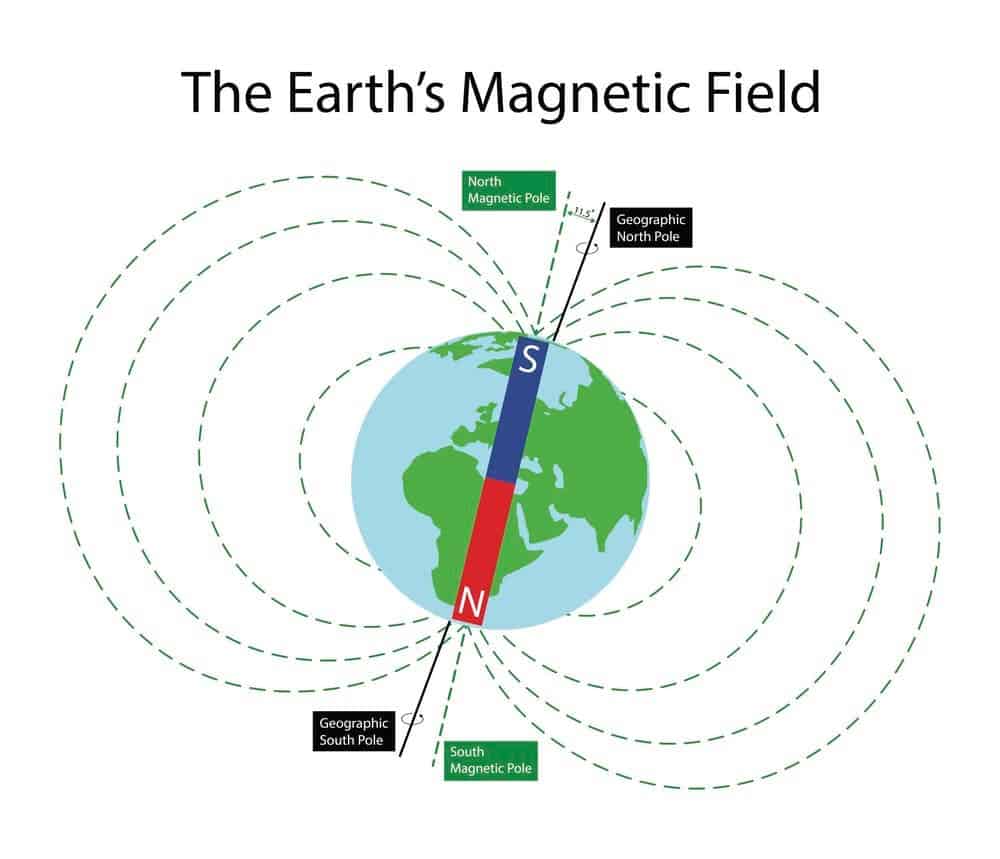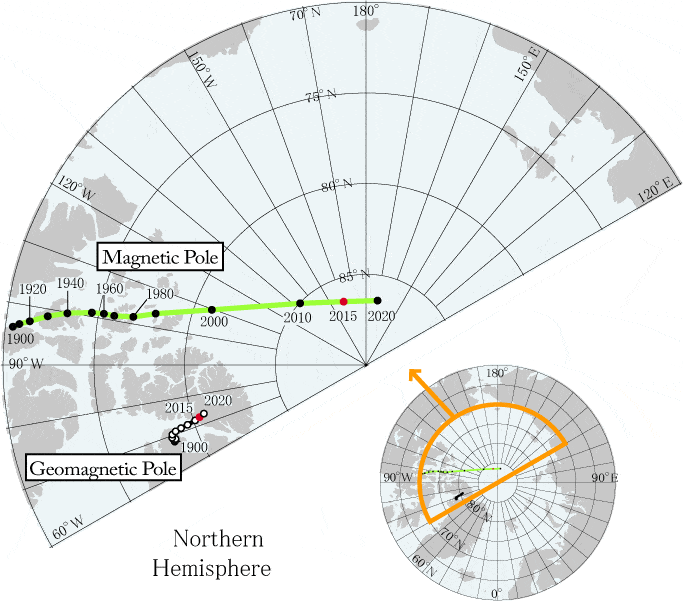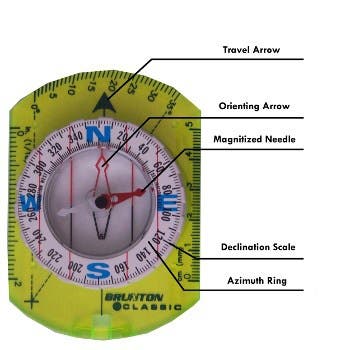
Before Google Maps and even GPS, people used magnetic compasses for over 900 years in order to reliably navigate around the world.
Their longstanding and widespread use is owed to a combination of factors. From a usability or UX design standpoint, the compass is a work of genius. A compass will always point north, so a user needs only to orientate themselves based on the four main points: north (N), south (S), west (W), and east (E). You don’t need to know how to read or write to use a compass, which makes it accessible to all ages, classes, and nationalities.
But have you ever wondered how a compass works? The answer lies in the mysterious forces of the earth’s magnetic field.
How a magnetic compass works
A compass works by using the earth’s magnetic field to align a magnetized needle. The needle, made of a magnetized material such as iron, is suspended on a pivot point, allowing it to rotate freely as it aligns towards the top of Earth’s magnetic field. The north pole of the needle, marked by the color red on most compasses, points towards the earth’s magnetic north pole.
When you hold a compass and turn it, the needle aligns itself with the earth’s magnetic field, pointing north. This allows us to determine the four cardinal directions: north, south, east, and west.
The basic physical principle of the compass is magnetism. This fundamental physical phenomenon arises from the force between objects that produce magnetic fields that attract or repel other objects.
The most familiar example of magnetism is a bar magnet, which is attracted to a magnetic field and can attract or repel other magnets.
Every magnet has two poles, north, and south. Like poles repel, while opposite poles attract. This is something everyone probably experienced at least once in their lives while toying with refrigerator magnets pushed end to end.
The first scientist in history that investigated the properties of magnetism was Thales of Miletus around 2,500 years ago. Around the same time, the Indian surgeon Sushruta performed surgical procedures with the help of natural magnets, such as the mineral magnetite, while the Chinese first described using magnets to attract a needle in the first century of this current era.
The very first compasses were made of a magnetized needle attached to a piece of wood or cork that floated freely in a dish of water. When the needle settled, the marked end would point toward magnetic north.
Our planet essentially has one giant bar magnet built inside it. The planet’s outer core is formed of liquid iron which constantly moves as the planet’s interior gradually cools down. This motion creates electric currents as electrons move through the liquid and, in the process, the energy of the fluid is converted into a magnetic field. If we imagined that Earth’s magnetic field is similar to a bar magnet (or dipole), then we can locate a geomagnetic north and south pole. This is an oversimplification of the complexity and variation of Earth’s true magnetic field but for the sake of simplicity, it will do.
However, the planet’s dipole is actually reversed, with its magnetic south pole orientated upwards near Earth’s geographic north pole and vice-versa. So a compass technically points to Earth’s magnetic South Pole, but for navigation purposes, we’re interested in the geographic North.

Why a compass doesn’t point toward the true North Pole
A compass doesn’t point towards the exact location of Earth’s geographic north pole, which is the “top” of the planet relative to its axis of rotation (imagine it as a kind of invisible rod that passes through the planet). Instead, it points towards the magnetic north pole (technically the magnetic south pole but for the sake of avoiding confusion we’ll use the same designation), which today lies somewhere in the middle of the Arctic.
Earth’s northern magnetic pole isn’t fixed but, rather, is in a perpetual motion driven by the movement of the planet’s liquid outer core. In the last couple of decades, scientists have noticed that the northern magnetic pole has been shifting away from the Canadian Arctic toward Siberia at an unprecedented rate. Compared to where it was a century ago, the magnetic North Pole has moved about 600 miles (1,000 kilometers).

Up until the 1950s, the north magnetic pole had been moving at a rate of about 11 km (7 miles) per year but since the 1990s, this rate has jumped to about 54 km (34 miles) per year. Strangely, the south magnetic pole has shifted very little during this time.
The difference between the magnetic north Pole and the true north pole is known as the angle of declination. Every compass is fitted with a declination scale, which you can adjust based on your location and the map you use so the compass always points towards true north.
However, if you’re not navigating a ship and are just hiking through the woods, adjusting the angle of declination is more often than not overkill. Most of the time, you’ll do fine treating the north a compass shows as though it were the precise indication of the geographic north pole. However, if your destination is hundreds of kilometers away, declination becomes mighty important to factor in — otherwise, you could miss your target by tens if not hundreds of meters. In some areas, the difference between magnetic north and true north can be as much as 20 degrees.
How to read a compass
The magnetic compass wasn’t formally invented for navigation until the 11th century in China and 1187 in Europe. Its design hasn’t changed much since, apart from some non-essential improvements. If it ain’t broken, don’t fix it, the old adage goes. Although it should be mentioned that very sophisticated compasses exist such as gyrocompasses, astrocompasses, and radio compasses.
While the basic principle of a compass remains the same, there are several variations of the navigational tool. One popular variation is the orienteering compass, which includes additional features such as a rotating bezel and a sighting mechanism. These enhancements allow for more precise navigation and map reading.
Another variation is the GPS compass, which uses satellite technology instead of the earth’s magnetic field to determine direction. These compasses are commonly used in outdoor activities such as hiking and camping, as well as in aviation and marine navigation.
Your typical magnetic compass, however, is very simple. It will help you figure out which direction is north and, when paired with a map, it becomes a powerful tool for navigation. No batteries or internet connection is required.
While entire books about navigating with a compass have been published, anyone can learn the basics with just a few simple concepts.
First, it’s good to get a handle on the main components of a compass. The most important part is the red needle which spins and points to the magnetic north pole. Other components you should know are:
- the direction of travel arrow shows the direction that you want to travel along or the bearing you are taking. It is fixed parallel to the sides of the base plate and aligned with the fixed index line on the edge of the compass housing.
- the degree dial, also known as the azimuth ring, is a twistable dial surrounding the housing with units of degrees.
- the orienting lines are lines within the housing that run parallel to the orienting arrow.
- the orienting arrow is fixed on the baseplate, aligned to the ‘north’ marking.
- additionally, some compasses have scales along the edge of the base plate to measure distances on maps, as well as luminous strips and a magnifying glass to assist navigation.
Now that you know what each component does, it’s time to hold the compass correctly. Place it flat on your palm or right on a map placed on a flat surface.
Turn the degree dial until the orienting arrow lines up with the magnetic arrow so both point north. Now when you look at the direction of the travel arrow, you’ll learn the direction you’re facing. For instance, the direction of the travel arrow is between N and E, which means you’re facing northeast. If you want a more accurate reading of the direction, write down the degree markers on the compass.
It’s a good idea to correct for declination. Remember declination compensates for the offset between the location of the geographic north pole and the magnetic north pole. You can correct for declination by either adding or subtracting the declination amount from your bearing in degrees, depending on whether or not you’re in an area with east declination or west declination. The declination amount should be specified in your map but just make sure you use a recent one because it changes significantly every few years.
To accurately follow the direction of the travel arrow, look straight down at the arrow, then focus on a distant object like a tree or telephone pole. Use this as a guide.
To navigate by map, mark your current position as best as you can, as well as your intended destination. Draw a straight line between the two points. Now, line up the edge of your compass on this line so that the travel arrow is the direction you wish to travel. Twist the degree dial until north on the map and the orienting arrow are aligned. Once you place the compass in your palm, turn until the orienting arrow and the red magnetic needle are lined up. Congrats, now you’re in the right direction.
Advanced technology such as GPS has made navigation effortless. But it’s also made us very bad at orientation. If you’re an explorer at heart, then you’ll want to own and learn how to use a compass.
A compass may seem like a simple tool, but it relies on the complex and ever-changing forces of the earth’s magnetic field to function. Whether you’re a hiker, a sailor or a pilot, a compass is an essential tool that helps you find your way. Next time you use a compass, take a moment to appreciate the science behind this humble navigational tool.



